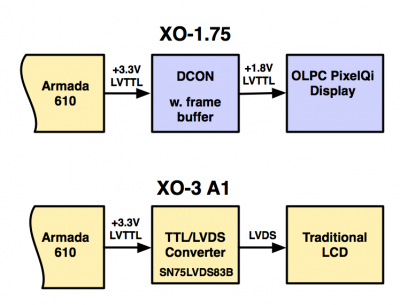Display Power
This page details the power savings provided by the XO Laptop display architecture.
Contents
Introduction
OLPC has consistently strived to provide a laptop with the lowest power consumption possible. Early work on the XO-3 A1 prototype provided an excellent opportunity to directly compare differences in power consumption.
The results show power savings (130 mW) in every use case, and significant power savings (> 1W) in several important use cases such as use with indoor/outdoor lighting and reading/browsing.
In the XO Laptop display architecture (labelled XO-1.75 in the above diagram), the system display controller outputs video data as 18 bit +3.3V LVTTL to a Display CONtroller (DCON). This DCON performs data manipulations and filtering if necessary, then performs the function of an LCD module Timing Controller (TCON) before outputting a +1.8V LVTTL signal which is routed directly the LCD gate and source drivers mounted on the display glass. The display is a transflective display custom to OLPC.
The XO-3 A1 prototype used a different approach, due to time and money constraints. Instead of a DCON chip, it uses a conventional LVTTL/LVDS converter chip (the TI SN75LVDS83B) and a recent technology (2011) display. This display uses an LVDS interface, and integrates the LVDS receiver and TCON into the source driver mounted on the glass.
Both systems were instrumented to allow measurement of the power consumption of internal components. Additional information about the instrumentation, along with power measurements is available for both XO-1.75 and XO-3 A1.
System Idle and Display On
The first comparison is the power saved when the system is running with the display turned on. The XO-1.75 display subsystem consumes 424 mW (not including backlight or memory) compared to 565 mW on the XO-3 A1 prototype.
| XO-1.75 | XO-3 | |
| MMP2 Display Ctrl. | 90 mW | 70 mW |
| DCON | 125 mW | - |
| LVDS Converter | - | 150 mW |
| LCD Module | 205 mW | 345 mW |
| Total | 435 mW | 565 mW |
The real power savings comes from the transflective aspect of theOLPC/PixelQi display, which allows operation without a backlight in bright light, and operation with less backlight power indoors. The backlight in the OLPC/PixelQi display uses between 0 (in bright light) and 0.9W. The backlight in the display in the XO-3 A1 prototype uses between 0.5 and 1.9W ! At "half backlight brightness", the OLPC display subsystem uses 630 mW less power:
| XO-1.75 | XO-3 | |
| Display Subsystem | 215 mW | 220 mW |
| LCD Module | 205 mW | 345 mW |
| Backlight | 465 mW | 950 mW |
| Total | 885 mW | 1515 mW |
Starting with XO-1.75, the XO laptop even automatically turns off the backlight if the ambient light levels make it superfluous (such as outdoors). In the outdoor case, the OLPC/PixelQi Display is a clear winner, at 2W less power (ignoring further savings while in reading mode):
| XO-1.75 | XO-3 | |
| Display Subsystem | 215 mW | 220 mW |
| LCD Module | 205 mW | 345 mW |
| Backlight | 0 mW | 1900 mW |
| Total | 420 mW | 2465 mW |
Memory Power
The amount of power required by the host frame buffer memory is not included in the above numbers. This was done as the main system memory on the XO-3 only uses two DDR3 chips (128Mx16), versus the four used in the XO-1.75 (128Mx8). Another problem with a direct comparison is the different size of the frame buffer --- 1200 x 900 on XO-1.75 and 1024 x 800 on the XO-3. For comparison, the measured increase in power draw when outputting video is 146 mW on XO-1.75 and 70 mW on XO-3.
Measurement Error
The slight decrease in display controller power consumption between XO-1.75 and XO-3 is not explained (although it is proportional to the change in display resolution, 75%).
Likewise, there is some uncertainty in the power draw measurements on the +3.3V bus on XO-3. We would expect the SoC's +3.3V power consumption to decrease slightly when the display controller is disabled, as the LVTTL video output becomes quiescent. On XO-1.75, we see a 15 mA decrease (ofw_nodisp.html vs ofw_idle.html). On XO-3, we see an increase of roughly 15 mA (ofw_nodisp3.html vs ofw_idle3.html). Earlier tests (ofw_nodisp2.html vs ofw_idle2.html) had leakage into the LCD module --- we found some and are looking for more.
The touchscreen is currently not being placed into its low power mode. The power it draws is ignored when discussing system power in suspend or idle.
System Suspended and Display On
The presence of the DCON in the display path allows further power savings, by allowing the system to go into a suspended state while maintaining an image on the display. This use mode is not supported by the XO-3 A1 prototype, which has no DCON. In this mode, the XO-1.75 laptop is capable of sustaining a displayed image for only 850 mW (no backlight, linux_sus_noback.html) vs. 1850 mW (linux_idle.html) if automatic suspend is disabled.
| Suspended | Idle | |
| Display Subsystem | 130 mW | 135 mW |
| LCD Module | 220 mW | 265 mW |
| Other system power | 500 mW | 1450 mW |
| Total | 850 mW | 1850 mW |
In the suspended case, much of the remaining system power draw is the 802.11b/g networking subsystem, which remains powered and functional.
